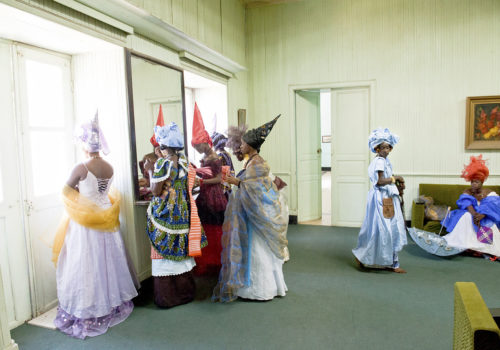In Senegal, the emancipation of women, prestige and wealth are measured by finery. From elaborate hairstyles to shimmering headscarf and sophisticated clothing, to embroidered shoes and the tinkling of gold of bracelets, Senegalese women use fashion for socio-political and economic purposes, as well as to celebrate their own history. This is the aim of the Signares series by Fabrice Monteiro presented by the MAGNIN-A gallery from May 28 to July 31, 2021.
Produced in 2011 by the Belgian-Beninese photographer, this series pays tribute to these influential women from Senegal’s Petite-Côte, the Ile de Gorée and Saint-Louis, whose rise took place in the 18th century.
In 14 photos, Monteiro reveals the incredible fate of this female caste whose power still occupies a prominent place in Saint-Louisian and Gorean societies today.
The photographer set up his models, dressed in the creations of the Senegalese Mame Fagueye Ba, in the old-fashioned setting of the remains of the palaces of the governors of Saint-Louis and Gorée. Through his images, Fabrice Monteiro draws a link between the past and the present and tells the story of these women who have marked the history of this country.
THE SIGNARES, WOMEN OF INFLUENCES
The signares (from the Portuguese senhoras) were young black or mestizo women, from the Petite-Côte of Senegal, in the trading posts of Rufisque (Rufisco) in the 17th century, then of Gorée and Saint-Louis until the middle of the 19th century. .
This Frenchization of the Portuguese word senhora (lady) originally designates African women who, living in cohabitation with influential Europeans, acquire an economic role and a high social rank. Signares seem to have existed since the end of the 15th century in Portuguese trading posts on the entire western coast between Senegal and Cap des Palmes. This name then applies to any woman who derives a certain notoriety either from her ethnic mix or from her skill as a shopkeeper, often both at the same time.
The signares succeeded during various periods of occupation in resisting the governors and officers who regularly challenged their power and privileges. These women were renowned for their bewitching beauty and their wealth, which they skillfully brought to fruition over time. Between daily coquetry and Sunday feasts, they led independent lives far from patriarchal domination. Even today, the descendants of the signares wield a strong power of influence within society.
Fabrice Monteiro, born in 1972, Belgium. Lives and works in Dakar, Senegal.
Fabrice Monteiro is an Agouda, descendant of Brazilian slaves with Portuguese names. Son of a Beninese father and Belgian mother, he grew up in Benin. After studying industrial engineering, he began an international career as a model, traveling the world and discovering the photographic medium. In 2007 he met the New York photographer Alfonse Pagano and developed his photo studio skills and passed behind the camera, Fabrice Monteiro’s photos are at the intersection of photojournalism, fashion photography and tableau vivant.
“The diversity of my cultures of origin is my first source of inspiration. Relations between Africa and Europe have constantly oscillated between attraction and rejection, empowerment and denial, recognition and anger. They have never been indifferent. The history of Afro-European peoples in recent centuries, the complexity of which I have inherited right down to my genes, guides all my artistic choices and gives me a unique perspective. “
He makes portraits his favorite medium and, in each of his series, addresses a strong issue linked to the African continent which he addresses through the prism of identity. His latest work “8 Mile Wall” explores the stereotypes that arose during the period of slavery and the colonial era. The series is based on a conversation he had as a child with his father, when he realized that, as a black man, the only way to be treated with respect and consideration in Europe in that era was to wear a three-piece suit. He deconstructs these automatic thoughts created by aesthetic details, whether they are costumes or accessories.
Fabrice Monteiro : Signares
May 28 – July 31, 2021
Galerie Magnin-A
118 Bd Richard Lenoir – 75011 Paris
















